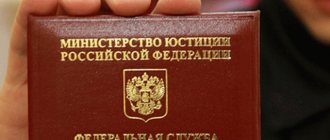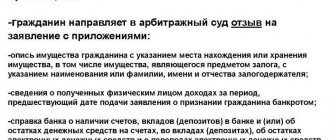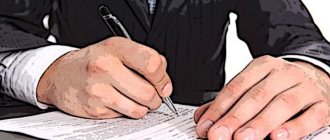What is enforcement proceedings
Property can be seized by a bailiff only if enforcement proceedings have been opened.
The basis is a decision to initiate proceedings and the presence of a writ of execution (court order, writ of execution, resolution of the Federal Tax Service, State Traffic Safety Inspectorate and other authorized bodies), if their demands for payment of money are not fulfilled by the person who is obliged to pay them.
The order to initiate proceedings must be sent to the debtor and other parties to the case via mail. The date of notification of the debtor is the day when the resolution was handed over to him against his signature. From the moment the notification is received, the countdown begins for the period during which the debtor can voluntarily execute the court decision. At this time, as a general rule, compulsory methods of collection are not used.
Exception for the application of compulsory recovery within the period for voluntary execution:
- the debtor did not want to receive a postal notification;
- the postal item was returned due to the absence of the addressee after the deadline;
- The claimant sent the bailiff an application to seize the debtor's property.
When should you think about the fate of your property?
After court decisions on debt collection come into force, bailiffs receive writs of execution. Now the bailiff can begin enforcement proceedings.
He goes in search of an apartment or other place of residence of the debtor. By mail, he sends the debtor a copy of the resolution on the commencement of enforcement proceedings. From this moment on, the debtor may lose part of his property.
The debtor may be given several days to repay the debt voluntarily. If he does not take advantage of this opportunity, then in five days a resolution will be issued to describe the property in the debtor’s apartment. And the amount of his debt will increase by another 7 percent.
The bailiff informs the debtor about his visit in writing, by phone or via SMS. The visit time for carrying out enforcement actions is set from 6 to 22 hours on weekdays. Visiting debtors at night and on weekends is prohibited, unless this is an exceptional case when the procedure cannot be postponed.
We invite you to read: My amount of property tax debt
How can property be seized?
Seizure of the debtor’s property can be carried out in several stages:
- describe and seize property, draw up the appropriate document;
- evaluate property;
- transfer property for sale (sale at auction, commission sale);
- the implementation procedure itself.
If the property is not sold for any reason, the bailiff must offer the claimant to take the seized item to pay off the debt. If the plaintiff agrees, then an amount equal to 75% of the appraised value of the seized property will be credited to him to pay off the debt. If the claimant refuses to accept the property, then it must be returned to the debtor.
Enforcement proceedings and its principles
The proportionality of the amount of debt and the value of the property subject to seizure is one of the main principles when applying measures in the form of seizure of property. The bailiff does not have the right to seize the debtor’s property if its estimated value significantly exceeds the available amount of debt.
The law establishes a list of things that are not subject to seizure at all:
- the only residence of the debtor and his family (apartment, house, other residential premises);
- household items that you cannot do without (a single bed, furniture, dishes, electric and gas appliances for cooking, etc.);
- Kids' things;
- items for individual use (shoes, clothing);
- property for carrying out labor or professional activities;
- state awards, prizes;
- food (in an amount not less than the subsistence level for the defendant and all members of his family;
- livestock feed;
- seed material for seasonal sowing.
Law enforcement practice shows that the above list can include many different things. Whether a bailiff can seize this or that property - in each specific case the approach is individual.
Seizure of the debtor's property
The resolution to seize the defendant's property is the basis for seizing the property and drawing up an inventory report. A copy of the resolution must be given to the debtor.
The seizure procedure must be recorded in a special document - an act of seizure (inventory of property). This act must be filled out by the bailiff who is carrying out the arrest procedure, in his own hand as a carbon copy in 2 copies. Seizure of property in enforcement proceedings is not allowed if the amount to be recovered does not exceed 3,000 rubles.
Act on seizure of property
The seizure of property is formalized by an act in which it is necessary to indicate:
- date of compilation;
- basis (no. of proceedings or writ of execution) for making an arrest;
- full details of those present during the arrest: the debtor, other persons (including specialists);
- a list of all seized property. Each item must be described in detail with all characteristics: appearance, presence/absence of damage, check of working condition;
- preliminary (in the opinion of the bailiff) estimated value of the property seized;
- information about witnesses;
- information that the debtor is prohibited from disposing of the seized property;
- how the property will be stored (seized, left for storage by the debtor or transferred to other persons);
- a note that all participants in the procedure have been explained their rights.
All property is inspected by the bailiff personally. The defendant must check the correctness of the information entered and certify the document with his personal signature.

Seizure of property to secure a claim
Seizure of property to secure a claim - this decision is made by the court when the plaintiff in a civil case applies to the court with a statement of claim to seize the debtor’s property before a decision is made on the merits. This measure is necessary to exclude facts of the defendant’s diversion and concealment of property. In such proceedings, the seized property is not transferred for sale, but remains in the debtor’s custody until the case is considered by the court.
Is it possible to exclude property from the inventory?
When an inventory of the debtor's property is carried out by bailiffs according to registration, all things located in the residential premises are considered to belong to the debtor personally. Accordingly, they are included in the inventory act. But in practice, there are often situations when, for various reasons, things belonging to third parties are stored in the house. And their owners, after completing the inventory, will have to defend their property in court.
Important! The debtor in this situation cannot challenge the ownership of certain things.
The owner of the property must apply to the court at the place of residence of the debtor or at the place of registration of the debt collector. If the value of the item is less than 50,000 rubles, the case will be dealt with by a magistrate. In other cases, the issue must be resolved through arbitration.
The claim must reflect the following circumstances:
- how the item got into the property inventory;
- how long the owner has owned the disputed item;
- how can the owner prove his right of ownership.
As evidence, checks and receipts confirming the acquisition of the disputed property by its owner, a will or certificate of the right to inherit the disputed item, and witness testimony may be attached to the statement of claim. Photographic materials are also considered evidence, from which it follows that the disputed item belongs to the applicant.
Important! A copy of the arrest warrant must be attached to the claim.
A receipt for payment of the state fee will need to be attached to the application. It should be remembered that in this case the statement of claim is of a non-property nature - the plaintiff challenges the actions of the bailiff, and does not demand the return of property. Therefore, the amount of the duty should not depend on the value of the item. In accordance with paragraph 3 of paragraph 1 of Article 333.19 of the Tax Code of the Russian Federation, the state duty in this case is:
- 100 rubles – if the plaintiff is an individual;
- 2000 rubles – if the claim is filed by a legal entity.
Important! In case of disagreement with the courts regarding the amount of the fee, we recommend referring to law enforcement practice. Precedents can be found in the legal reference systems Consultant Plus or Garant.
If the case is resolved positively, the plaintiff will receive a ruling to exclude the disputed property from the inventory. This document will be the basis for returning the disputed property to the owner. In this case, the bailiffs are obliged to lift the arrest from it and impose it on other things belonging to the debtor, the value of which is commensurate with the property excluded from the inventory.
Is it possible to challenge the actions of the bailiff?
From the moment the act is drawn up, a 10-day period begins so that the debtor can appeal the actions of the bailiff, or to exclude some seized property from the act.
Property that is seized can be excluded from the act if it is not the property of the debtor, pledged property, or is included in the list of property the seizure of which is prohibited by law. Items can only be excluded from the act through a judicial procedure. The debtor sends a statement of claim to the court. If the claim is accepted by the court, the sale of the seized property is suspended. After 10 days, items must be handed over for sale.
Witnesses
When drawing up an act of seizure (inventory of property), there must be at least 2 witnesses - persons who are not interested in the outcome of the case. By their signatures, witnesses must certify that the information included in the act is correct and complete. If an arrest is imposed without witnesses, it may be considered invalid.
Valuation of property upon arrest
During the process when property is seized, the bailiff basically independently evaluates the seized property, taking into account market prices and the degree of deterioration of things. The final price must be fixed in the resolution on the valuation of the seized property; a copy of the resolution is sent to the debtor within 5 days from the date of arrest. In case of disagreement regarding the assessment of the value of property, it is necessary to involve an appraiser. The debtor can appeal the result of the property assessment in court.
Procedure for working with property
Imposing an encumbrance on the property of a debtor is a strictly regulated procedure. It is carried out according to the following algorithm:
- bailiffs describe the debtor's belongings;
- at least two witnesses are involved in the process of compiling the inventory;
- the items included in the inventory are assessed;
- the contents of the inventory are seized;
- seized property will be confiscated;
- the confiscated goods are sold.
The funds received as a result of the sale are used to pay off the identified debt.
Important! You can learn more about the procedure and the composition of documents accompanying this process from Article 80 of Federal Law No. 229 “On Enforcement Proceedings”.










